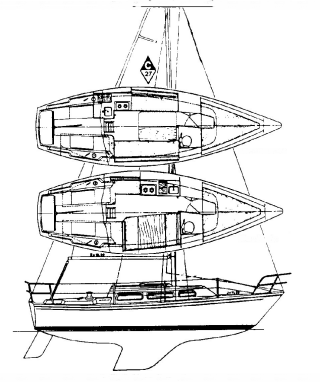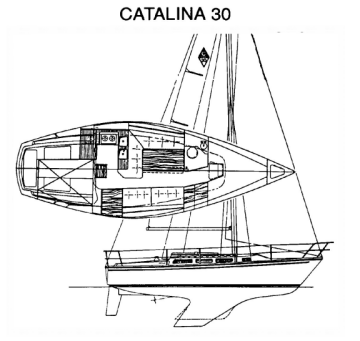Page down
for my views on the Catalina 30.
the Catalina 27s
There have been 2 different designs of the Catalina 27.
The first Catalina 27 was designed by Frank Butler and Bob Finch. They sold like
hotcakes. My 1974 was hull #1416. Almost 1500 27s were built in basically the
first 3 years of production. Hovever, the Catalina 27 has had a major re-design
since it was first introduced in 1971. The original 27 ceased production in
1991. Total production was 6662 hulls. The current model, the Catalina 270,
debued in the fall of 1992 if I'm not mistaken. (See chart below, comparing the
1974 and 1996 Catalina 27s and the Cal 2-27.) This re-design is the reason that
the 27 Catalina didn't place in the longest run (years) of any sailboat over 25
feet. That honor must go to the Catalina 30. The same basic Catalina 30 has been
produced from 1973 and is still going strong, making it the longest produced
sailboat over 25 feet in the world. I include the specs below for both designs
of the 27. The profile shown is of the 1974 model year. 
The image at right is
of a 1974 Catalina 27. The top views in the profile show both the
traditional and the dinette style interiors. The '74 was over a
foot narrower than the newer design.
The newer, wider boat provides
more living area but is more complicated to trailer. The extra
width also provides more initial stability with a thousand pounds
LESS ballast. The new design, no doubt, is faster. One drawback to
the wider boat is that some of the wide fat designs can turn
"turtle" and remain there for quite a length of time in the right
conditions (remember Fastnet?). Maybe I worry too much. I've never
heard of this happening in the Great lakes. I still like the old
design better. If you want a light fat sailboat, why not just omit
ALL the lead and buy a catamaran.
- NEW STYLE Catalina 27 (1996)
- LOA = 27' 0", LWL = 23' 9", Beam = 9' 10"
- Draft (fin keel) = 5' 0", Draft (wing keel) = 3' 6",
- Displacement Fin = 6240 pounds, Displacement Wing =
6460 pounds
- Ballast (fin keel) = 1840 pounds, Ballast (wing keel)
= 2060 pounds
- Engine = IB diesel, Designer = Frank Butler
- Sail area = 316 Sq. Ft., sail measurements: I=33'4", J=9'3",
P=28'3", E=11'6"
- OLD STYLE Catalina 27
- LOA = 26' 10", LWL = 21' 9", Beam = 8' 10"
- Draft (fin keel) = 4' 0", Draft (shoal keel) = 3' 3"
- Displacement Fin = 6850 lbs
- Ballast (fin keel) = 2700 lbs., Ballast (shoal keel) = 3050
lbs.
deep keel was
fin, shoal keel was Scheel type.
- Engine = IB (gas or diesel) or outboard
- Sail area = 340 Sq. Ft., sail measurments: I=34'5",
J=11'25", P=28'66", E = 10'5"
- Designer = Frank Butler / Robert Finch
NOTE: The older style Catalina 27s most all weighed more than
this. I think that the factory weighed an outboard model without an
engine to get this light weight. Every lift operator that ever
handled my diesel powered 27 told me that she weighed over 7500
lbs. These new hydraulic lifts can pinpoint a boat's weight with
amazing accuracy.
I owned a 1974 Catalina 27 (#1416) back in the '70s. It was
probably one of the best boats I've ever owned. It was quick,
comfortable, and built like a rock. I've owned larger sailboats but
for my sailing, here in the Great Lakes, I like a 27 footer. They
have a tall enough mast to grab good air and the sails are still
small enough to manage easily. Since our sailing is usually just my
wife and I, a 27 offers ample accommodations. Insurance and dockage
is much cheaper for the 27 footer.
My 1974 27 was a bit heavier than the new 27 but probably had a
stronger hull. My 1983 Irwin Citation only had a hull thickness of
about 1/4 inch at the turn of the bilges. My 1974 Catalina had
almost 5/8 inch in the same area. In order to save weight, Irwin
depended on high tech glass mat and resins plus a unidirectional
grid structure for hull strength while the older boats just used
layer after layer of good old hand laid cloth and glass mat. My
opinion... give me the extra weight and the layer after layer of
glass mat.
These new redesigned 27s have a slightly different keel shape,
offer a wing keel as an option, and have an open transom with steps
up into the cockpit.
If you purchase a new 27 here are some of the features: 5 year
blister protection limited warranty*, pedestal steering with engine
controls, double lifelines, stern boarding platform with swim
ladder, self tailing winches, double spreader rig, full batten
main, internal halyards led aft to stoppers, molded-in nonskid
deck, genoa furling.
The older Catalina 27s are usually a good, inexpensive way to get started in sailing. However, there are
several problems to be aware. Leaks are the
biggest problems of many 27s and water finds
its way below through the hull-and-deck joint, the hatches,
the chainplates and deck fittings. Chainplate leaks often result
in bulkhead delamination.
Check the through-hull fittings and replace any gate
valves with seacocks. Check for backing plates on deck fittings, occasionally
owners have added these and sometimes by remounting the fittings they have
inadvertently created leaks. The lack of backing plates allowed deck fittings to
move, and the gelcoat around chocks, cleats, and other fittings is often crazed and cracked. Other items to inspect are the
spreaders and particularly the cast aluminum spreader sockets
as they're prone to failure. The result can
be a mast toppling into the drink. Apparently Catalina
is aware of this problem and has a ready-made
replacement kit available.
* many fiberglass hulls built in the 1980s had blistering
problems. There were very few of these problems in the 70s and they
seem to have it corrected now. I don't know what the caused this
but it cost many owners many thousands of $$$. Make sure you check
this part of the warranty when purchasing a fiberglass hull.
the Catalina
30
The Catalina 30, designed by Frank Butler, has had the longest
production run of any boat in it's size class. It was first
designed, if I'm not mistaken, in 1974 and is still going strong
today. I would have said this about the Catalina 27 but the hull
has been changed too much to call it the same boat. This popular
Catalina 30 is the exact same boat as it was designed in the early
'70s, must of been a good one!


- LOA = 29' 11"
- LWL = 25' 0"
- Beam = 10' 10"
- Draft (fin keel) = 5' 3"
- Draft (wing keel) = 3' 10"
- Ballast (fin keel) = 4200 pounds
- Ballast (wing keel) = 4300 pounds
- Displacement Fin = 10,200 pounds
- Displacement Wing = 10,300 pounds
- Engine = Inboard diesel
- Sail area = 446 Sq. Ft. Standard Rig
- I=41'0", J=11'6", P=35'0", E=11'6"
- Sail area = 446 Sq. Ft. Tall Rig
- I=43'0", J=13'2", P=37'0", E=12'0"
- Designer = Frank Butler
Since 1974 the principal dimensions have remained the same at
LOA 29' 11", beam 10' 10", displacement of 10,200 lbs. and standard
draft of 5' 3". From 1977, shoal draft was offered as an option,
first with a fin keel drawing 4' 4" which was replaced with a
winged keel design drawing 3' 10" in 1988. The displacement and
ballast of shoal draft boats are 100 lbs. greater than the standard
draft versions to compensate for the higher center of gravity of
the ballast.
Some of the more common problems are deteriorated deck cores,
compression fatigue at the mast step, failed wooden spreaders,
failure of lower chain plate attachments on older model boats,
leaks and separation at the keel to hull joint, and delamination
and damage along the vulnerable deck to hull joint caused generally
from minor docking incidents over the years.
If I were to purchase a new Catalina 30, it would probably be a
standard rig with the wing keel. If, for some reason, I purchased a
tall rig it would have the deep fin keel. Being 60 years old now, I
would still probably get the wing keel, standard rig and the
largest diesel available.
This page was last updated
on May 26th, 2010
This Web Page Created with PageBreeze Free HTML
Editor
|

![]()
![]()
![]()
![]()
![]()
![]()
![]()
![]()

